

Buddhist and Jain institutions tried to appropriate independent nature deities and cults into their metaphysical systems.

Provided by The Map Academy
Mythological figures often represented visually in a pair, the yaksha and yakshi are found across early Buddhist, Jain and Hindu art. Yakshas are male figures, and yakshis are their female counterparts. They were believed to be spirits that inhabited trees, mountains, rock mounds, rivers, and oceans. Their prevalence in sculpture, usually in association with natural elements, is considered a sign of widespread nature worship in the early historic period (6th–3rd century B.C.E.).
The earliest mentions of yakshas are found in the Jaiminiya Upanishad Brahmana, where the word is used only to describe a wondrous thing. By the time that epics such as the Ramayana were composed, yakshas were referred to as spirits or a group of figures similar to, but elevated and distinct from, ghosts and demons. In early Buddhist literature and sculpture, yakshas frequently appear in subordination to the Buddha; sources such as the Therigatharefer to them as guardian spirits who impart good morals. However, outside of the bounds of organized religions, many monumental yaksha figures were produced in the early historic period; these and some references in texts suggest that yakshas were worshipped as tutelary deities in some areas, as well as independent deities of trees or other natural entities.
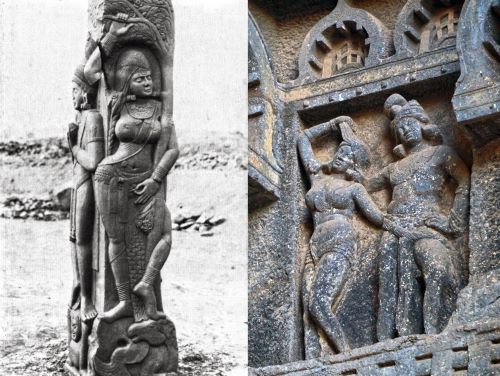
In Tibetan Buddhist sources, yakshas and yakshis are claimed to be people who served an individual or a community during their lifetime, reborn as benevolent spirits. Jain texts similarly claim that these spirits are reborn as mortal human beings once their merit has been exhausted. These may indicate that growing Buddhist and Jain institutions attempted to appropriate hitherto independent nature deities and cults into their metaphysical systems.
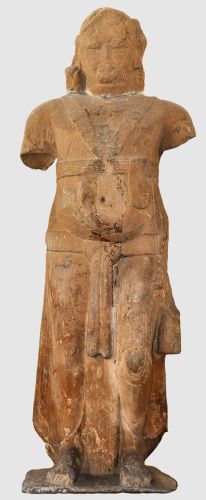
Among the earliest known images of yakshas and yakshis can be found in sculptural reliefs on the Bharhut and Sanchi stupas. They are generally depicted as attendant figures, sometimes to the aniconic Buddha. This may be seen in sculptures from the Mauryan and post-Mauryan period, such as the yakshas from Parkham and Vidisha and the yakshis of Besnagar and Didarganj. In the last centuries B.C.E. and early centuries C.E., the yaksha iconography adopted softer features such as a prominent belly.
A stupa is a hemispherical structure with a circular base that supports a dome with a spire and often contains religious or burial items. Its name derives from the Sanskrit word stupa, meaning “heap.” Notable stupa sites include Sanchi and Bharut, Madhya Pradesh, and Borobudur, Java.
This is especially prevalent in sculptures of Kubera, considered the king of yakshas in some traditions, but also the god of wealth in others. He is depicted with abundant jewelry and wears a dhoti tied underneath a protruding belly. The yaksha figure from Pitalkhora, Maharashtra, may be considered an example of Kubera iconography. Kubera’s mounts include a horse, elephant or a ram. He is also depicted holding a mace or a club.
A ruler of the yakshas and a guardian deity in Hindu, Buddhist and Jain religious mythologies, Kubera is known as a deity of wealth and treasure and is one of the dikpalas (lords of the cardinal directions), as well as a lokapala (guardian of the world). While the iconography of Kubera may vary, a common depiction is of him as a short figure with a protruding belly, often carrying a money purse or a pot and a club. In Buddhist iconography, he is usually depicted with a mongoose to his left.
The yaksha Manibhadra was also considered an important figure, with several Buddhist, Jain and Hindu literary references to his popularity and worship. The yaksha sculpture from Parkham is widely believed to be a representation of Manibhadra.
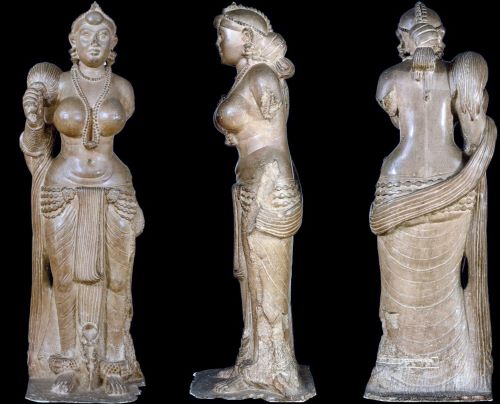
Yakshis are generally depicted as voluptuous figures with nude upper bodies, wearing necklaces, bangles, and anklets. Their lower torsos and waists are decorated with clothing and more jewelry. Due to their associations with the natural world, they are often represented next to or holding onto trees—such yakshis are referred to as shalabhanjikas, which may reference the birth of the Buddha under the sala tree by his mother, Maya. They might also hold a pot with water or a lotus flower, both associated with fertility, or might be represented alongside a makara or naga.
The equivalent of the Capricorn zodiac sign within Hindu astrology, a makara is a mythical sea creature that is believed to be the mount of the deities Ganga, Narmada and Varuna. It is often depicted with a terrestrial (elephant, antelope etc.) front half and an aquatic (fish, crocodile etc.) back half. A naga is a type of being, half human half serpent, and again, there are variations in how nagas are depicted.
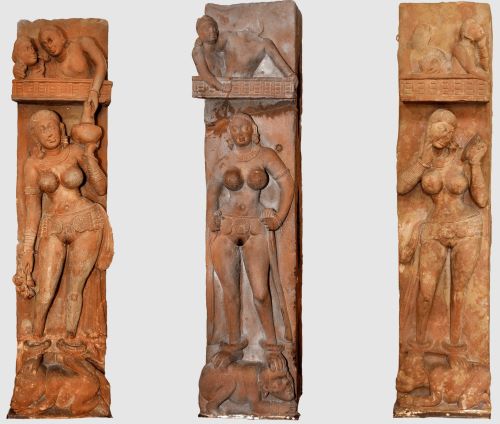
Yakshi figures are sometimes depicted standing on top of figures short in stature, that are depicted with unsmiling faces, and fearsome expressions, as seen in the Kushan period Bhuteshwar yakshi reliefs. Between the second century B.C.E. and the third century C.E., the Kushan empire became a dominant force in the northwestern part of the subcontinent we now know as India.
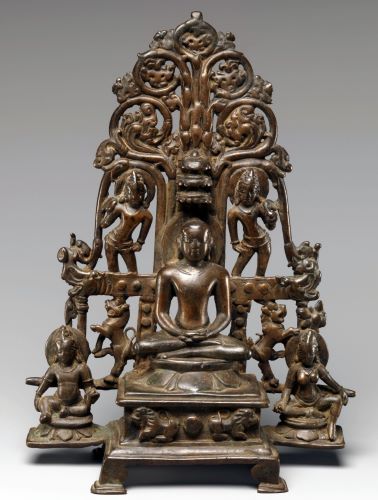
Though yakshas and yakshis faded in popular Buddhism and Hinduism by the middle of the first thousand years C.E., they were adapted in some Tantric Buddhist rituals as the fulfillers of wishes. They continued to be depicted and sometimes worshipped in Jainism through the early and late medieval periods, starting in 500 C.E. and up until the 15th century, where they are portrayed as attendant figures to the twenty-four Tirthankaras, with the yaksha on the left and yakshini on the right side.
Also known as jinas, tirthankaras are teachers and guides in Jain devotional practices who lead their followers on the path of dharma. In their iconographical depictions, the tirthankaras may be shown seated in the padmasana posture or standing with their legs and feet joined together in the kayotsarga posture. They are also distinguished by emblems unique to each jina’s iconography. In the Jain belief system, each cosmic age has twenty-four tirthankaras; the tirthankaras of the present cosmic age are Rishabhanatha (also known as Adinatha), Ajita, Sambhava, Abhinandana, Sumati, Padmaprabha, Suparshva, Chandraprabha, Suvidhi (also known as Pushpadant), Shitala, Sreyamsa, Vasupujya, Vimala, Ananta, Dharma, Shanti, Kunthu, Ara, Malli, Munisuvrata, Nami, Nemi, Parsvanatha and Mahavira (also known as Vardhamana).
Additional Resources
- Vidya Dehejia, “South Asian Art and Culture,” on The Metropolitan Museum’s Heilbrunn Timeline of Art History.
- A.K. Yaksas Coomaraswamy, Yaksas, Part I. (Washington, D.C.: National Museum of Asian Art, Smithsonian, 1931).
- Susan L. Huntington, The Art of Ancient India: Buddhist, Hindu, Jain (New York and Tokyo: Weather Hill, 1985).
- Gauri Parimoo Krishnan, “Nature Goddesses,” Goddess: Divine Energy (Sydney: Art Gallery of New South Wales, 2006).
- Amita Sinha, “Nature in Hindu art, architecture and landscape,” Landscape Research 20, no. 1: pp. 3–10.
- Gail Hinch Sutherland, The Disguises of the Demon: The Development of the Yaksa in Hinduism and Buddhism (New York: New York State University, 1991).
Originally published by Smarthistory, 08.09.2022, under a Creative Commons Attribution-NonCommercial-ShareAlike 4.0 International license.


